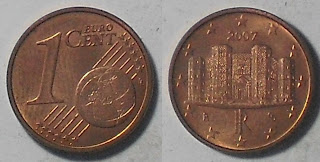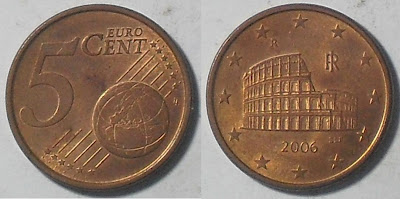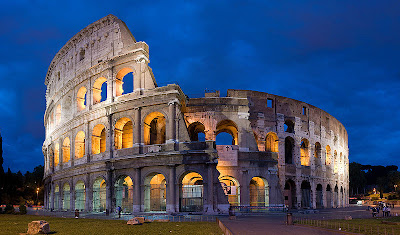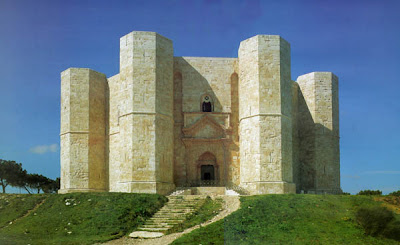1 cent, 2007
 The one cent coin shows the Castel Del Monte, a 13th century castle situated in the Apulia region of Southeast Italy. It was built by the Holy Roman emperor Frederick II around 1250. It does not have a moat or drawbridge and apparently it was never intended as a defensive fortress.It was completed in 1240 and was used primarily as a hunting lodge by Frederick until his death in 1250. It was later turned into a prison, used as a refuge during a plague, and finally fell into disrepair. It originally had marble walls and columns, but all were stripped by vandals.
The one cent coin shows the Castel Del Monte, a 13th century castle situated in the Apulia region of Southeast Italy. It was built by the Holy Roman emperor Frederick II around 1250. It does not have a moat or drawbridge and apparently it was never intended as a defensive fortress.It was completed in 1240 and was used primarily as a hunting lodge by Frederick until his death in 1250. It was later turned into a prison, used as a refuge during a plague, and finally fell into disrepair. It originally had marble walls and columns, but all were stripped by vandals.The fortress is an octagonal prism with an octagonal bastion at each corner. Each floor has 8 rooms and an eight-sided courtyard occupies its centre.The octagon is thought to be an intermediate symbol between a square (representing the earth) and a circle (representing the sky). Frederick II may have been inspired to build to this shape by either the Dome of the Rock in Jerusalem, which he had seen while on Crusade, or by the Palace Chapel of Aachen Cathedral.
Castel Del Monte
 The Italy 2 cent coin shows the Mole Antonelliana of Turin.A Symbol of the city and daring building, it was begun in 1862 by Alessandro Antonelli as a Jewish temple; after a period of stop, the works began again in 1878 with the construction over the vault of a granite room, on which a lantern made of two floors and then a high cone which transforms the square plan into a circle plan are based.
The Italy 2 cent coin shows the Mole Antonelliana of Turin.A Symbol of the city and daring building, it was begun in 1862 by Alessandro Antonelli as a Jewish temple; after a period of stop, the works began again in 1878 with the construction over the vault of a granite room, on which a lantern made of two floors and then a high cone which transforms the square plan into a circle plan are based.A series of conic and cylindrical elements completes the already high spire; these elements end with a cusp of pyramidal shape on and octagonal plan, realised in two separate parts.
A genius with wings on the spire ends the works in 1889, when the direction of the building yard is passed to Costanzo Antonelli, son of the dead architect.
The Mole, with its 163,35 metres high, is the tallest brick building in the world.At the time of building it was the tallest building in the world and to date its the tallest in the city.In August 1904 an hurricane knocked over the statue, substituted by a star, and in 1953 a storm knocked over more than 40 metres of the cusp, substituted between 1958-61 by a metal structure covered in stone, also reinforcing the inferior structures.
Inside a room in square plan is covered by a nerved pavilion vault, outside the four sides take an homogeneous configuration.
A panoramic lift leads to the little temple under the spire, from which you can enjoy a beautiful city landscape and of the surrounding mountains.
The Mole is the actual seat of the National Museum of Cinema.
Mole Antonelliana, Turin

5 cent, 2006
 The Italy 5 cent coin shows the Flavius amphitheater on the obverse, more commonly known as the Colosseum of Rome. The Colosseum was created for the purpose of gladiatorial contests and public spectacles like reenactment of famous battles, animal hunts, executions, mock battles, chariot races etc. The Colosseum as we know it today had some predecessors made of wood. The amphitheater had to house thousands of people and was susceptible to giving in under pressure and fire was always a hazard. After the reign of Nero, it was the Flavian dynasty which started the construction of the amphiteatre in 72 AD in marble and such more stable materials, and it was completed in 80AD. After the name of the dynasty it came to be known as the Flavius amphiteatre. The name Colosseum was given because of the colossal statue of Nero at the entrance.
The Italy 5 cent coin shows the Flavius amphitheater on the obverse, more commonly known as the Colosseum of Rome. The Colosseum was created for the purpose of gladiatorial contests and public spectacles like reenactment of famous battles, animal hunts, executions, mock battles, chariot races etc. The Colosseum as we know it today had some predecessors made of wood. The amphitheater had to house thousands of people and was susceptible to giving in under pressure and fire was always a hazard. After the reign of Nero, it was the Flavian dynasty which started the construction of the amphiteatre in 72 AD in marble and such more stable materials, and it was completed in 80AD. After the name of the dynasty it came to be known as the Flavius amphiteatre. The name Colosseum was given because of the colossal statue of Nero at the entrance.Although the Southern side of the elliptical structure was destroyed in an earthquake long back and today it is in ruins, it remains an iconic symbol of imperial Rome, one of the greatest works of Roman architecture and engineering and also one of the major tourist attractions in Rome.
The Colosseum of Rome





No comments:
Post a Comment